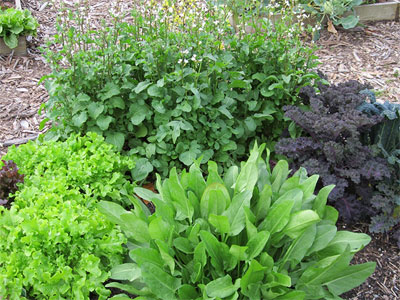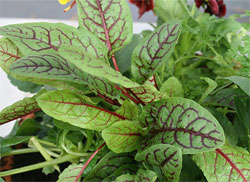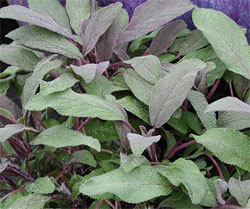From the Magazine: Unusual Winter Evergreens

Long-lived French sorrel (foreground) makes itself at home in a bed filled with winter veggies like lettuce and kale. All photos by Sharon Lee Smith.
Little-known herbs yield flavor landscape beauty
by Sharon Lee Smith
Gardening during the winter months is such a great treat. I grew up with snow and ice, where winters were long and gray, so I greatly appreciate the beauty of a Texas winter. Herbs play a big part in my winter landscape. I love to incorporate cool-season herbs into my gardens for visual interest and for their culinary qualities. Rosemary, thyme, and lavender are some of the well-known staples, but there are many other evergreen herbs.

Red sorrel is a short-lived perennial that can provide lively color in cool-weather containers and beds.
Foliage color and texture always influence my decision when choosing a plant. The winterscape is stark, so herbs like red sorrel (Rumex sanguineus) provide lovely foliage color. This short-lived perennial is diminutive in size – just a foot tall – with bright red veining. Red sorrel is great for a border or in a mixed pot. It has the same tangy, slightly lemon flavor as green-leaved French sorrel (Rumex acetosa). French sorrel stands 18 inches tall and wide, making a dense clump of foliage. I have 15-year-old plants still flourishing in my gardens. Sorrel is used fresh in salads or can be cooked in sauces.
Leaf celery (Apium graveolens var. secalinum) resembles parsley on steroids. It grows taller than Italian parsley, but the leaf tastes just like celery. Add it fresh to salads or your favorite boursin cheese recipe. Its emerald-green foliage color is cheerful looking, and it provides great fluff in a bed of dormant perennials. It’s considered a biennial in the garden because it grows just two years, so allow leaf celery to re-seed and perpetuate itself.

The author loves to pair salad burnet with pansies and violas in her winter garden.
One of my all-time favorite plants is salad burnet (Sanguisorba minor). The tidy green mounds of foliage look their best during the winter. Plants can enjoy full sun during the winter, but afternoon shade in summer is of great benefit. I use it as a border or a backdrop to pansies. Burnet has a cucumber flavor and makes a delicious herbed butter or flavored vinegar.
Prostrate winter savory (Satureja montana prostrata) grows just a few inches tall but about 18 inches wide. The tiny green leaves have a spicy, peppery flavor that pairs well with meats or many soups. Use it as a permanent groundcover for its soft, lacy appearance. During the late summer, tiny white flowers cover the foliage.
Cardoon (Cynara cardunculus) is a member of the artichoke family and has lush silver leaves. Reaching 4 feet high and wide, this bold plant can make quite a statement in a garden.

Picturesque purple sage is mild-flavored and easy to grow in containers.
Sage is always nice to have in the garden, especially for its culinary use in holiday recipes. Purple sage (Salvia officinalis ‘Purpurascens’) has a mild flavor, and its dusty purple color adds another dimension to the landscape. The plant is compact, growing to 12 inches tall and slightly wider, and like most herbs, it prefers well-draining soils. I use this herb quite often in mixed containers.
There are annual herbs grown during the cool Texas months that are attractive and useful, but not permanent. Often referred to as the parsley of France, chervil (Anthriscus cerefolium) has a sweet anise taste and delicate bright green foliage. Arugula is a favorite to spice up salads and, of course, I love to grow cilantro to add to salsa and other Mexican food favorites.
These tasty and attractive herbs are nice additions to winter landscaping. They add height and texture to the traditional winter flowerbed, and it’s a treat to have them close at hand for harvesting and using in the kitchen.

